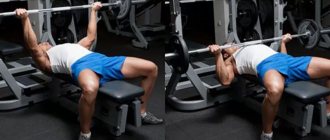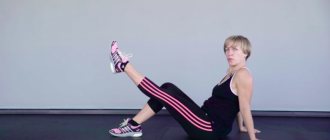Jogging is also called “shuffling”, “relaxed” running or “jogging” from the English. “jog” - “jog, push.” If you look at Ozhegov’s dictionary, the word “coward” means slow, calm running. To summarize, we conclude that jogging is jogging at a leisurely pace, with a relaxed step. The average speed of a runner is no more than 8 km/h, which makes it easy to run long races.
What is jogging?
Jogging (jogging) is suitable for both young and old people, due to its moderate speed of 7 to 9 km per hour on average. The duration of the run, as well as the speed, can be chosen by the person himself, choosing the optimal conditions for himself. This type of aerobic physical activity will be useful for both a beginner athlete, a housewife or even an elderly person, as well as a professional athlete, an employee of a special unit, or an overweight person.
Duration, speed and conditions may vary according to the runner's wishes. So, for example, by inserting the player's headphones into his ears and leisurely walking along the paved path of a residential area, a person can receive a daily boost of energy, strengthening all systems of the body.
Jogging in the army is another matter when, having risen before dark, the company begins to move in pouring rain and heavy winds, hiding behind a mountain pass at an altitude of two and a half kilometers above sea level. With noticeably thin air and constant ascent with full gear. Both the first and second examples will be the same jogging.
The average recommended running speed does not mean that the pace cannot be kept below 7 km/h. On the contrary, you need to train in your comfort zone , even if the average speed is 4 - 5 km/h.
If you have shortness of breath, pain in the side and general fatigue, you can reduce your speed or start walking. After regaining your strength, you can increase the pace again.
Also, with such loads, you can change the angle of inclination , run uphill or on uneven surfaces, the number of calories burned will increase, and body weight will decrease faster, even at a low pace.
Training plan for beginners
Week 1
- Monday: 5 minutes of intense walking, then alternating a minute of jogging and a minute of walking (10 repetitions).
- Wednesday: 5 minutes of vigorous walking, 2 minutes of jogging, 2 minutes of walking (5 reps).
- Friday: 5 minutes of intense walking, 2 minutes of jogging, 1 minute of walking (7 reps).
Week 2
- Monday: 5 minutes of intense walking, 3 minutes of jogging, 2 minutes of walking (5 reps).
- Wednesday: 5 minutes of vigorous walking, 4 minutes of jogging, 2 minutes of walking (4 repetitions).
- Friday: 5 minutes of intense walking, 5 minutes of jogging, 2 minutes of walking (4 repetitions).
Week 3
- Monday: 5 minutes of vigorous walking, 7 minutes of jogging, 3 minutes of walking (3 repetitions).
- Wednesday: 5 minutes of vigorous walking, 10 minutes of jogging, 3 minutes of walking (2 reps).
- Friday: 5 minutes of vigorous walking, 10 minutes of jogging, 3 minutes of walking (3 repetitions).
But, of course, we must not forget that a coach can draw up a plan that suits you individually. And the above diagram is just general advice for starting training.
You may be interested in: Health running: benefits and contraindications
The benefits and harms of jogging
Like any running, it is aimed at strengthening and developing body systems such as the cardiovascular and respiratory systems. This aerobic exercise uses all the muscles of the body. Running stimulates testosterone production in both men and women, which has a positive effect on libido, mood and overall emotional state. Jogging improves the body's metabolic processes and is considered an excellent way to combat excess weight.
A heart rate below 120 beats will not provide much benefit from running, metabolic reactions do not start in the desired mode for fat burning, and calorie consumption is lower.
To strengthen your heart and lose weight, you should keep your heart rate in the range of 120-160 beats per minute. This heart rate will allow you not to overload the cardiovascular system, the main thing is not to exceed the maximum rate.
How to start?
From words to actions or how to approach jogging correctly, we will tell you in 5 points, each of which must be given attention. If you strictly follow the recommendations, then jogging will bring tangible results much faster.
Turn to your health
Every trainer will say that before using physical activity, you need to know the state of your health. Health problems can not only nullify all efforts, but also cause a lot of trouble. If you have known diseases or suspect their presence, then before starting classes it is strictly recommended to consult a specialist.
If there are no health problems and there is no reason to see a doctor, then try to monitor two main health indicators: pulse and blood pressure. Fitness bracelets with an additional heart rate measurement function, for example Xiaomi Mi Band 1S pulse (what I use myself), will help you cope with the task. Measure your heart rate in the morning and evening, as well as before and after your run. This will help identify heart problems that may only appear with sufficient exercise.
We also recommend measuring your blood pressure at least once a day. Remember that the average difference between the upper and lower pressure should be 40 units.
Start with a warm-up
Despite the fact that jogging is often itself a means of warming up, we recommend performing a set of several exercises immediately after you start running.
- Perform circular rotations with your arms forward and backward 4 times in each direction. Repeat the exercise 5-8 times.
- Perform opposite movements with your hands (left forward, right backward). After 8 rotations, change direction. Repeat 2-4 times.
- Run, raising your knees high for 10-15 seconds.
- Swinging the shin back, same time.
- Running with straight legs forward – 10-20 seconds.
A simple set of 5 exercises will help shorten the run-in period and increase the useful part of your run. Also, exercise 2 will help concentrate attention and engage the nervous system in the active work.
Running technique
Performing technical elements when jogging is characterized by a low range of motion. During motor processes, muscles that are not involved in active work should be in a relaxed state.
While running, the arms are bent at the elbow joint 90 degrees. Hand work is performed by inertia and does not require accentuated work. The shoulder girdle is in a relaxed state. The gaze is directed 10-15 meters ahead. This position of the upper limbs and head will ensure minimal energy expenditure, which will allow you to run a greater distance.
Hand movements occur along the ribs or forward-inward, back-outward. When moving the arm forward, the hand reaches the middle of the chest or solar plexus. The abduction ends when the hand remains in the area of the ribs.
The body is in an upright position and only slightly tilted forward by 5-7 degrees. When running, oscillatory movements in the vertical and horizontal projections should be minimized.
Turning right or left sideways forward is highly undesirable. When running, the shoulder line should be straight. Otherwise, the technique is disrupted, which leads to a decrease in the efficiency of movements and the applied efforts are less beneficial. If the turns of the body are significant and resemble rocking, then there is an excessive load on the lumbar region and, as a result, pain after training.
Monitor your breathing and pulse
Breathing and pulse are indicators that can signal the body’s reaction to the load received. If after the start of the run the indicators rise sharply, it means that the pace is set high and you should slow down a little.
After you start running, your heart rate always increases significantly, but after a few hundred meters of steady running, you may find that it has become lower. This indicates a normal response to physical activity.
Since jogging is recreational, the recommended heart rate is in the range of 120-140 beats per minute. By adhering to the proposed range, you can be sure that the body will adequately perceive physical activity and the response will be positive.
An increase in breathing rate is always correlated with heart rate. If you perform several quick breathing cycles while sitting on the couch, you may notice an increase in heart rate and upper blood pressure.
The recommended breathing rate during slow running is one inhalation or exhalation for every 4 steps. This figure may vary depending on lung capacity. If jogging is systematic, the breathing rate will decrease and reach 5-6 steps per inhalation or exhalation, which will indicate lung training.
Try to breathe comfortably. If during jogging it is not enough for you to inhale or exhale every 4 steps, then breathe more often. Don’t try to adapt to the norms, anyway, after a while you will surpass them.
Choose the right shoes
Properly selected shoes will help you get the most out of your jogging. Remember that running shoes are the best option. The use of sneakers or other sports shoes is not recommended due to the lack of shock-absorbing soles.
Shock absorption helps protect the knee joints from damage due to the impact force of landing. Additionally, the shock absorption promotes forward movement due to the spring effect, and also guarantees traction with the surface in the presence of deep treads.
When choosing sneakers, pay attention to their weight. The average weight of one sneaker should not exceed 500 grams. We recommend giving preference to shoes whose soles are made of helium material. Foam sneakers are also a good option, but such material becomes hard over time and the shock-absorbing effect is lost.
Using the recommendation will help you avoid unpleasant consequences, and will also increase the impact of each run. Exercise correctly and systematically and remember that there is no more universal remedy than running.
Who should jog and when?
Athletes use this type of running as a warm-up or after a hard workout in order to restore breathing and heart rate. Jogging is used during rehabilitation in the post-traumatic period. Such a load, combined with stretching and health training, will speed up the regeneration process.
Read more about cool down after training →
This type of aerobic exercise can be an excellent way to achieve the goals of any person, even those with problems with the cardiovascular system, since such exercise maintains a moderate heart rate.
Stages of Cardio Training
The whole lesson can be divided into two parts.
Preparatory
At this time, the body adapts to the stress - the pulse quickens, breathing becomes more intermittent, then gradually recovers, and the muscles warm up.
For the first 5-10 minutes you cannot increase your speed, you should run slowly or even walk quickly, and only after adaptation processes can you speed up.
Remote
This stage involves completing a certain distance. It must be gradually increased to achieve the planned results.
Jogging technique
Jogging, first of all, is a workout aimed at improving your health, which does not involve heavy workload. Therefore, this type of physical training requires an average pace and a short step length. When jogging, you need to move your feet in short steps.
A good option would be to push your toes upward from the surface; this technique will consume more calories. However, with this technique, the load will be focused on the calf muscles. And also, when running slowly, short steps are taken with the entire foot lowered to the ground.
- It is imperative to control the position of the spinal column; under no circumstances should the pelvis be pulled back or tilted forward.
- Pay attention to breathing; when jogging, it should be calm and easy; if the runner feels stress on the respiratory system, shortness of breath appears, the pace should be reduced, or even go to a walk.
- If you feel thirsty while running, you cannot ignore it. Drink small sips as needed while running.
Contraindications to classes
There are a number of diseases for which jogging is contraindicated.
Among them:
- Myopia, glaucoma. Jogging can cause retinal detachment.
- Any chronic diseases during the period of exacerbation. Here the advisability of jogging should be discussed with your doctor. Excessively active training can lead to a deterioration in your general condition.
- Colds. You should not run with a high body temperature, a sore throat or a stuffy nose. You should wait until you feel better, and only then resume training.
- Joint diseases - arthritis, arthrosis, osteochondrosis, intervertebral hernia. Even light running puts a lot of stress on your back and knees, which worsens the condition of your joints.
- Diseases of the respiratory system. Jogging requires active work of the lungs and can provoke an exacerbation of bronchial asthma or cause pulmonary failure.
- Diseases of the heart and blood vessels. Cardio training, which includes running, puts a high load on the heart muscle. A healthy person who regularly plays sports trains her endurance. The heart muscle of a sick person may not be able to withstand the proposed loads.
It is not recommended for older people to start running. At 60 years old, joints, ligaments, and muscles find it difficult to adapt to physical activity. Not only should you avoid running, but older people should also avoid high-intensity aerobic exercise. A replacement for jogging will be Nordic walking or yoga.
Records among the world's best athletes
From all of the above, we can make a top list of athletes who were able to set a human running speed record. The top positions in it will be occupied by the following runners:
- Usain Bolt (Jamaica): 11-time world champion, unsurpassed by anyone so far in the 100 and 200 meters.
- Dennis Kimetto (Kenya): became the world's strongest at the Berlin Marathon on September 28, 2014.
- Paula Radcliffe (Great Britain): Named the world's best female athlete in 2002. She still holds the record set in 2003 at the London Marathon (2 hours, 15 minutes, 25 seconds).
Among the football players there are also many players who could compete with the best sprinters. The fastest of them is Antonio Valencia from Manchester United. This man's fastest running speed on the field is 35.1 km/h. Winger Gareth Bale of Real Madrid is distinguished by his ability to make quick bursts, accelerating in a matter of seconds. His teammate Cristiano Ronaldo can move around the field just as powerfully, with a recorded speed of 33.6 km/h.
Movement is the key to health
Russian physiologist I.P. Pavlov argued that physical activity can replace any medications, but not a single medicine can become a full-fledged alternative to movement. This statement is 100% correct.
Swedish doctors managed to prevent the development of diabetes in 100 people who were at high risk for this disease in just 6 months of regular exercise. Thanks to physical activity, all participants in the experiment normalized their metabolism, including carbohydrate metabolism.
Van Aaken, a specialist in the treatment of cancer, observed 1000 people for 6 years. At the same time, half of them ran regularly, and the other half of the people did not bother themselves with physical activity. During the study, 29 people who ignored sports died from cancer. Among the people running, only 4 people became infected.
Another living example of the healing power of movement is Valentin Dikul. Thanks to physical exercise, he managed to restore his injured spinal column and receive the title of “hero.”
Warm-up
As a warm-up before running training, you can use a complex of joint gymnastics:
- Circular movements of the head. You can alternate with bending. The movement must be performed smoothly. You should start with shallow bends in each direction (left, right, forward and backward).
- Rotational movements in the shoulder joints. The movement is carried out around an axis passing through both joints.
- Rotational movements in the elbows. Performed in both directions.
- Body tilts. You should start with shallow bends in all directions.
- Squats. To maintain balance, it is allowed to straighten your arms in front of you.
A more intense warm-up is not required, since jogging is used by experienced athletes as a warm-up.
General recommendations
It is best to jog in a forest or park area, where the air is clean and saturated with oxygen. If there are no such places nearby, then stadiums, squares, and streets with light traffic are quite suitable. The chosen route should not have steep ascents and descents. When running along a horizontal path, it is much easier to control speed and fatigue.
Running on asphalt is not recommended, since the hardness of the surface will negatively affect the condition of the joints. It is advisable to choose dirt roads or special coatings used in stadiums.
You should start jogging for 10 minutes a day, alternating between running and walking. Gradually, you will need to increase the duration of running and reduce the duration of walking. Jogging for weight loss will be effective with three 40-minute workouts per week. It is advisable to jog in the morning, half an hour after getting up. Before running, you can drink a cup of coffee (no cream or sugar), which will give you extra strength and help you shed extra pounds faster.
People with the following diseases should not jog: congenital heart defects, spinal injuries, arthritis, varicose veins, progressive myopia, glaucoma, diabetes mellitus, chronic kidney disease, arterial hypertension, or previous stroke or heart attack.
Previous article: Faster and more varied – types of running Next article: Long-distance running technique











